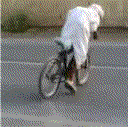Shifting down
One difference between shifting down on the racetrack and shifting down on the street is that on the track you only downshift when you're braking. You downshift to get into the right gear for a corner, and since you're accelerating all the way up to the moment you brake, you'll be braking when you downshift. A downshift must be done properly to be smooth. This is a point where you really don't want to lock the rear, and so you must match the rpms properly.
In the MSF, they just teach you to roll the throttle on to match the rpms. That takes time and can be harder to judge. They don't teach the throttle blip method because it's harder to explain and teach to new riders. If you have no trouble doing it the MSF way, continue to do it, except remember that on the track this might be harder because you're always braking hard at the same time.
Blipping the Throttle
What some people find much easier -- and I would like you to try out to see if it works for you -- is to blip the throttle as you downshift. The sequence is: pull in the clutch, and as you shift just blip the throttle hard with the ball of your hand (like you were trying to impress someone on the sidewalk), then let the clutch out. You'll find that if you blip the throttle hard enough, the revs will match themselves. Also, because the revs match so well, you'll need only a slight touch on the clutch to make the shift. Try this first with the engine off -- squeeze the brake lever hard, and practice rolling the throttle with the ball of your hand. You should be able to maintain a constant pressure on the brake lever while you're doing this.
Multiple Downshifts
To make things more complicated on the track, most of the time you'll be shifting down more than one gear. There's a number of ways to handle this. What I normally do on a very familiar bike is to keep the clutch in and blip the throttle for each downshift. That does increase the chance of ending up in the wrong gear if you miss a shift, so if you're going to get away with this you need to know the bike well enough to detect a missed shift without having to let out the clutch. Unless you have that level of confidence, you'll be more secure releasing the clutch for each downshift. If you're not blipping the throttle, in fact, you really need to do this to make sure you're matching the revs properly. Multiple shifts take time, so it's best to start downshifting as soon as you can, when you start braking. Most modern bikes slow down rapidly enough to change down all the gears as quickly as you can, but to start out allow more distance for braking and shifting until you are sure you won't over-rev the motor doing this.
From TrackDoD Novice Group Orientation
Subscribe to:
Post Comments (Atom)



No comments:
Post a Comment